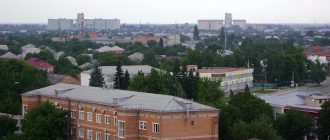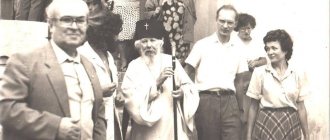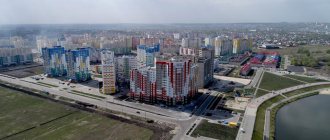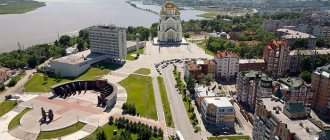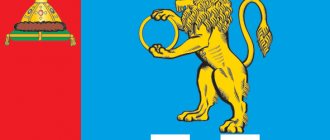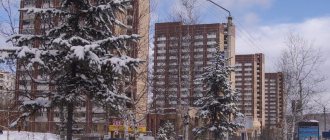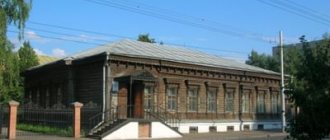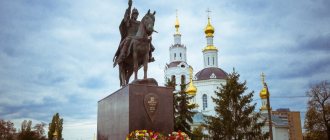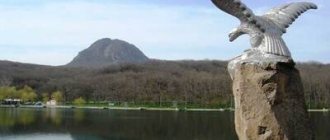Sanatoriums
The city of Pyatigorsk is famous for its sanatoriums, which are focused on treating patients with diseases of the musculoskeletal system and nervous system, digestion, skin, and gynecological diseases. There are more than 40 mineral water sources in Pyatigorsk. Nearby is Lake Tambukan, where sulfide silt mud is mined. At the foot of Mount Mashuk there is a unique radon mineral water source used to treat diseases of the musculoskeletal system. Of all the resorts of the Caucasian mineral waters, Pyatigorsk has the most diverse healing resources. There are about 25 sanatoriums here. All of them are multidisciplinary modern health resorts.
"Society of water drinkers of both sexes"
Goryachevodsk Postcard beginning 20th century. Image from fotostarina.ru
In 1812, when all of Europe was burning under Napoleonic fire, here in the North Caucasus its own history was being built - the first house appeared in the Goryachevodsk Valley. It was built by the solicitor Chernyavsky and thus, as historians believe, “laid the first foundation” for the resort. Of course, in 1809 the use of mineral waters for medicinal purposes was officially introduced here.
Chernyavsky’s experience turns out to be successful, after which construction at the resort is in full swing. The three houses are being built “at the invitation and persuasion of the main authorities” by the pharmacist Sobolev. The village of Goryachevodskaya, on the initiative of General Ermolov, is settled by 250 families of Volga Cossacks. 300 captured Polish soldiers and officers sent to Goryachevodsk are engaged in the improvement of the city, in particular, building a stone staircase leading to the baths located on Goryachaya Mountain.
And in 1820, a very curious tourist, Alexander Sergeevich Pushkin, appeared here, accompanied by the family of General Raevsky. He writes in a message to his brother: “60 Cossacks were riding around us, a loaded cannon with a lit fuse was trailing behind us... I lived in the Caucasus for two months; I really needed water and it helped me tremendously, especially hot sulfur water. However, I bathed in warm sour-sulphur, in iron and sour cold... I regret, my friend, that you and I did not see the magnificent chain of these mountains, their icy peaks, which from a distance at a clear dawn seem like strange clouds, multi-colored and motionless.; I regret that I did not ascend with me to the sharp top of the five-hill Beshtu, Mashuk, Iron Mountain, Stone and Snake Mountains.”
Vepkhvadze I.A., “Pushkin in the Caucasus” (1952). Image from artlib.ru
Pushkin’s biographer, Mr. Bartenev, wrote: “These original trips, this life is free, tempting and completely different from the previous one, this news and unexpected impressions, life in wagons and tents, various walks, nights under the open southern sky, and all around bizarre pictures mountains, new customs, unprecedented tribes, auls, sakli and camels, the wild freedom of the mountain Circassians, and several hours away a stubborn, cruel warrior with the great name of Ermolov - all this must have pleased young Pushkin extremely much.
Well, obviously, he was right - for a restless and energetic poet, such a lifestyle was certainly suitable. And he didn’t lose his beloved social life here. Journalist I. Radozhitsky, who visited the resort in 1823, wrote: “Having entered the town, I saw in all the courtyards many carriages of visitors and pretty people walking along the streets. The most military officers met; There were also dandies in fashionable frock coats and tailcoats... I found here a large, beautiful and rather elegant company of water drinkers of both sexes, jostling around the source of health... Ladies under umbrellas or in hats, under coats and in hoods, men in frock coats and with canes. There are no officials observed here.”
In 1826, the first hotel, also known as the first public building, opened in the city. It was called “Restauration”, which, of course, emphasized the peculiarity of the priorities of the local “water society”.
And in 1829 Pushkin came here again. True, he was passing through, but he noted changes for the better: “Today, magnificent baths and houses have been built... A boulevard lined with sticky trees runs along the slope of Mashuk. Everywhere there are clean paths, green benches, proper flower beds, bridges, pavilions. The keys are trimmed and lined with stone; police orders are nailed to the bathroom walls; Everywhere there is order, cleanliness, beauty.”
What to see
The most important wealth of Pyatigorsk is its natural resources. Therefore, among the attractions of the city of Pyatigorsk one cannot fail to mention beautiful parks with health paths. By cable car you can reach the top of Mount Mashuk, from where you can enjoy an unforgettable view of the Main Caucasus Range and the Beshtau, Zmeyka and other mountains. On the slope of Mount Mashuk there is Proval - an underground cave, a stone funnel, at the bottom of which there is a lake with healing mineral water. One of the attractions is the Aeolian Harp gazebo, named after the ancient Greek god Aeolus, lord of the winds. Below is Lermontov's grotto. We see the Mashuk spur, where the grotto is located, in a painting painted by M.Yu. Lermontov "View of Pyatigorsk".
Next to the Lermontov Baths, in the Tsvetnik park, there is Diana’s Grotto, formerly called the Elborus Grotto. On Mount Goryachaya, for the 100th anniversary of the Pyatigorsk resort in 1903, a sculpture of an eagle at the moment of a fight with a snake was installed. According to one legend, a snake bit a bird and the eagle died. But after drinking healing water, the bird managed to survive. This monument is the emblem of the Caucasian Mineral Waters. Vacationers can explore the site of M.Yu.’s duel. Lermontov and the place of the poet’s original burial. The Lermontov House museum presents an exhibition about the last days of the poet’s life and paintings on the themes of his works.
Pyatigorsky Boulevard, built in 1827–1828, is famous for its linden alleys. The continuation of Kirov Avenue to Proval is the beautiful and austere Provalsky Boulevard (now Gagarin Boulevard). The buildings of the Pushkin and Pirogov baths are interesting for their architecture. Back in the mid-19th century, a white-stone building of the Elizabeth Gallery appeared in the upper part of the gorge between Mount Goryachaya and the Mikhailovsky spur of Mashuk. Now this is the Academic Gallery, where the pump rooms of mineral springs are located. The site offers an amazing panorama of Pyatigorsk and the surrounding mountains.
Coat of arms
The coat of arms of Pyatigorsk is presented in the form of a French shield. It is divided horizontally into two halves.
In the center of the azure upper part there is an eagle turned to the right and tormenting a snake. The bird symbolizes greatness and victory, and the snake symbolizes evil and disease. They are located against the backdrop of the white silhouette of Mount Beshtau with five peaks.
On the scarlet background of the lower part there is a golden circle. Golden streams of water shoot out from it to the right and left. They reach the same – larger size. A large number of jets indicates the numerous healing springs of the city. Below is a golden key. The object embodies the historically important location of the settlement.
The artistic composition was approved by decision of the Duma of Pyatigorsk, Stavropol Territory No. 119-18GD dated September 22, 2007.
CAUCASIAN MINERAL WATER
Despite the fact that Pyatigorsk lies on the same latitude as Genoa, south of Venice and Yalta, its climate differs sharply from the climate of all these places, which is not surprising if we take into account that there is a sea everywhere there, which serves as a powerful climate regulator. Here the regulating factor is the mountains and extensive forested areas. Low humidity and dry air, weak eastern winds help to endure the summer heat. Clean air, filled with the aromas of pine needles and the freshness of snowy peaks, opens up deep breathing, invigorates and refreshes, like the water of a mountain stream.
The climate is steppe, combined with low-mountain climate, with moderate precipitation, low relative humidity, small and unstable snow cover.. The average altitude of the resort part of the city is about 520...525 m (510 - 550 m) above sea level. This is associated with a slightly lower atmospheric pressure, which ranges from 710 to 735 mm Hg. Art.
In winter, there are significant changes in atmospheric pressure, higher air humidity, and fog often appears. Frosty days and snow cover last from several days to 1-3 weeks. During frequent thaws, the air temperature rises to +10 – +22 °C.
The resort area, rich in underground mineral water sources, is relatively poor in surface water resources. It is crossed by the Podkumok River (and Kuma, bending around from the west - northwest - north) with several small tributaries and rivers. They are shallow, do not fully provide the area with drinking water, and are little used for recreation (since they are cold). But in the upper reaches (they originate in the Rocky Range (III), break through the Pasture Range (IV) with picturesque gorges) - these are pure mountain springs, visited by tourists with pleasure. The murmur of rivers among the stones and small waterfalls are characteristic of Kavminvod. The region additionally receives water for industrial, domestic and resort needs from Kuban through a special water pipeline.
There are no or negligible natural lakes with fresh water. The famous Tambukanskoe and Lysogorsk lakes (and Lake Karras, as well as the Gorkaya (salt.) and Gorkushka (g.-sol.) rivers) contain bitter-salty water and are valuable sources of medicinal mud. However, from the heights of the mountain peaks you can see how the mirrors of the lakes sparkle in the valley. These are large reservoirs in Essentuki and near Pyatigorsk (artificial lakes were also built in Zheleznovodsk). In summer, there are many vacationers, holidaymakers and local residents on the shores of these lakes.
The surrounding mountains are decorated with natural forests in which mighty oaks and snow-white birches, honey-bearing maples and lindens grow, and in the fall dogwoods, hawthorns, rose hips, barberries, and rowan trees turn red with berries.
The Mashuksky forest park covers the horseshoe Mashuk slopes and joins the Beshtaugorsky forest park stretching to the north and northwest of Pyatigorsk, being together with it a regional state reserve (1972).
The fauna is not so diverse due to the proximity of the city, but tourists are always delighted by squirrels, which can be found even in small public gardens in the very center of the city. Swans swim on the pond in Kirov Park in summer.
Pyatigorsk is known primarily as a resort city. But this is also a cultural center not only of the Kavminvod region, but also of the Stavropol Territory. North Caucasus.
Man began to live here from ancient times. This is evidenced by tools and household items discovered by archaeologists. But the first written mention of the Bishdag (five mountains) area with a source of hot water dates back to 1334, when the famous Arab traveler Ibn Battuta visited there. In the Middle Ages, Alans, Kabardins and Abazas lived in Pyatigorye.
The study of mineral waters in Russia began in the 18th century during the reign of Peter I. The Caucasian and Lipetsk springs were the first to be examined in Rus'.
In 1717, Peter I, during the Persian campaign, sent his physician G. Schober to the Caucasus to “look for spring waters that can be used against diseases” on the lands of the Beshtaugor Circassians, “to explore and describe the hot waters in the Terek, known as the Bragunovskys.”
The first scientific description of Pyatigorye and its healing factors was made by Academician of the Russian Academy of Sciences Johann Anton (Antonovich) Guldenstedt in 1773. He described the Hot Mountain and a crack along the mountain with a hot sulfur spring (main) flowing out of it (several mouths at the tip of the northwestern ridge of the mountain), as well as another hot spring flowing (to the southern spur) to the Podkumok River; examined Lake Proval, visited Tambukan and the Kumagorsky sulfur spring.
In 1774, according to the Kuchuk-Kainardzhi peace treaty with Turkey, part of Kabarda, together with more than half of Pyatigorye, went to Russia, and in 1781, according to the Treaty of Yassy, Russia acquired Greater Kabarda and the right bank of the Kuban, and thus “mineral waters finally became our property, except Narzan, which until 1806 was outside the Empire." Already in 1787, the taubii, ethnarchs and valii (elders, princes, rulers) of Balkaria turned to Count Potemkin with a petition for citizenship.
1780 - foundation and beginning of construction of the Konstantinogorsk fortress - one of the fortifications of the Azov-Mozdok defensive line (1777), an important role in the creation of which belonged to A.V. Suvorov - in the valley between Beshtau and Mashuk (4 km from Mount Mashuk), on the banks of the Podkumok River - in the territory of the current Novo-Pyatigorsk district.
The soldiers of the 16th Jaeger Regiment occupying the Konstantinogorsk fortress drew attention to the hot mineral springs of Mount Mashuk. This year is considered the official year of the founding of Pyatigorsk. A settlement gradually grew nearby, where soldiers who had served their time settled.
In 1793, the Russian Academy of Sciences sent the famous naturalist and traveler P.S. Pallas to the Caucasus, who described the springs in detail and made (for the first time a qualitative) chemical analysis of mineral waters. All analyzes of mineral waters before S.A. Smirnov were carried out outside the Caucasian Mineral Waters - in St. Petersburg, Moscow, Kharkov. The soldiers who lived near the hot springs were already familiar with their healing properties, and from them, among other things, the Russian scientist learned that sulfur baths are useful for skin diseases, rheumatism, gout, etc. The most important result of Pallas’s trip was the examination of Narzan, to whom he conveyed great significance and predicted a brilliant future. Pallas's message at the Academy of Sciences made a great impression, and interest in the Caucasian Mineral Waters increased significantly. After scientists visited and studied the hot waters, the news about the healing waters spread more and more widely, attracting patients from the most remote cities of the Russian Empire to the hot sulfur waters.
Subsequent studies of the Pyatigorsk mineral waters and Kislovodsk Narzan were carried out in 1801 by the chemist Simeon, and in 1802 by the staff doctors Krushnevich, Gordinsky and the pharmacist Shvenson. In terms of the completeness and accuracy of the salt composition, these analyzes can be considered the first in the history of studying the chemistry of these sources.
April 24, 1803 (St. Petersburg) - the official history of Pyatigorsk as a resort city begins, when the famous Rescript of Alexander I “On recognition of the national significance of the Caucasian Mineral Waters and the need for their construction” was signed.
During this period - 1800s - 10s. – the first Western European colonists settled in the vicinity of the resorts. The purpose of their invitation was to provide better amenities and food supplies for new Russian health resorts. Near Pyatigorsk in 1802, immigrants from Scotland G. Brunton and A. Paterson founded the Karras colony (since 1809, German colonists from the Volga region (Sarepta) have also settled here). In the vicinity of Pyatigorsk in 1819, the Germans founded the Nikolaevskaya colony, and in 1831 - Konstantinovskaya (to the east of Mashuk from Konstantinovskaya station to Karras, fragrant vineyards stretch to this day). Italian winemakers settled in the vicinity of Mount Camel (Kalaborka and Tempelhof).
In 1809-1810, the famous Moscow doctor Friedrich Iosifovich Haaz visited the Caucasian Mineral Waters. Dr. F. P. Haaz (as he was called in Russia) belongs to the honor of discovering new healing springs in Pyatigorsk; the result of his research was the book “My Journey to the Alexander Waters.”
1812 – the first house was built in the Goryachevodsk Valley. It belonged to Chernyavsky, a solicitor from Georgievsk.
1816-1827 - the years of command of the troops of the Separate Caucasian Corps by General A.P. Ermolov - in Goryachevodsk, at the foot of the mountain, soldiers built the Elizabethan baths, in front of which they laid out flower beds, and next to them they built the Ermolov baths, named in honor of their father-commander. Outside the city they laid out a vast garden with peaches, apricots and plums.
1822-1823 - a special construction commission was established (at the request of A.P. Ermolov) and the first architects were invited - brothers Giuseppe and Giovanni Bernardazzi, immigrants from Switzerland.
In 1823, for a more complete and comprehensive description of the Caucasus Mining Waters, A.P. Nelyubin, a professor at the Medical-Surgical Academy, was sent from St. Petersburg. In 1825, his major work “Complete historical, medical-topographical, physical-chemical and medical description of the Caucasian Mineral Waters” was published, which for many years was the basis for the development of the Caucasian resorts. On the initiative of Ermolov, in 1825, near Mount Mashuk along the Podkumok River (on both banks of the river), a Cossack village was formed, later named Goryachevodskaya.
In the 20s of the XIX century. For the first time, tolerable roads were built between the “groups” and to the district city of Georgievsk (then provincial center; soon, according to General Ermolov, Stavropol became the provincial city). In Pyatigorsk, the first state-owned hotel was built - Restoration (1825-1828), the first capital building of the Nikolaev (now Lermontov) baths, two officers' houses, the Tsvetnik park was laid out and a boulevard lined with linden trees was laid out, the romantic "Diana's Grotto" and the Aeolian Harp appeared " In 1824, General Ermolov issued an order appointing Dr. F. P. Conradi as the first (permanent, including in winter) chief physician at the Caucasian Mineral Waters.
May 14, 1830 - the expanded settlement of Goryachevodsk (Goryachie Vody) was elevated to the status of a district (district) city by decree of the Governing Senate, under the modern name Pyatigorsk. The name Pyatigorye was assigned to the entire northern (central) part of the Caucasian Mineral Waters region. This name is associated with the location of the five-domed Beshtau Mountain near Pyatigorsk. The name of the mountain is of Turkic origin and means “five mountains”.
Narzan baths [in Kislovodsk] were taken by patients after treatment with sulfur baths in Pyatigorsk and ferruginous baths in Zheleznovodsk. This treatment process corresponded to the existing view of the mountaineers, according to which the hot sulfuric Pyatigorsk waters, called “dead water” by the mountaineers, relaxed the human body, the warm Zheleznovodsk waters, called “living water,” revived the body, and the Kislovodsk Narzan, usually cold, informed the body heroic strength.
In 1837, a new city development plan was approved by the highest authorities. Nicholas I, when considering the projects, expressed a desire “for the Pyatigorsk church to be built with five domes” (like the five-domed Beshtau). The majestic Cathedral Church in the name of Christ the Savior, healing (quenching) the paralytic (Spassky Cathedral), was built for 22 years with donations and beautified the city in 1869 (the foundation stone of the temple was scheduled for June 25, 1847 - the emperor’s birthday; destroyed in 1935-1936) .
In the 40-50s. XIX century under the governor of the Caucasus, Prince M. S. Vorontsov, construction on the Waters revived again. Vorontsov can be considered the founder of the “culture on the CMS” industry; in each of the cities of the Kavminvod, galleries are being built (chief architect S.I. Upton): Elizavetinskaya (Academic) in Pyatigorsk (as well as Heat Sulfur Baths), source gallery No. 17 in Essentuki, Narzannaya in Kislovodsk, wooden in Zheleznovodsk (construction of many objects was suspended and delayed due to the earthquake that happened in Kavminvody in 1852). In Pyatigorsk in 1850, on the orders of Vorontsov, Russia’s first open-air museum was created - the Museum of Antiquities of the North Caucasus. In the middle of the 19th century, a systematic study of the Pyatigorsk resort began; F. A. Batalin made a great contribution to the study and systematization. Twice he descended into Pyatigorsky Proval to a depth of 26 m and described in detail Provalnoye Lake and its thermal waters; he managed to open several new, unknown keys. By personal order of Prince A.I. Baryatinsky, the first resort library at the CMV was founded in Pyatigorsk in 1859.
A significant contribution to the development of the Pyatigorsk resort was made by prominent scientists I. A. Guldenshtedt, P. S. Pallas, F. P. Gaaz, A. P. Nelyubin, F. A. Batalin; S. A. Smirnov. The latter initiated the founding in 1863 of the Russian Balneological Society in Pyatigorsk - the first scientific and practical organization in Russia that dealt with the research and use of healing factors given by nature. Dr. S. A. Smirnov, a man of broad erudition, and thanks to his organizational talent, managed to unite advanced doctors, physiologists, pharmaceutical chemists, engineers and geologists and put balneology in the Caucasian Mineral Waters on a scientific basis and become the founder of scientific balneology.
1893-1894 – the resort town was connected to Moscow by direct railway communication. At the same time, in the 90s, residents of the working-class village of Slobodka near the Pyatigorsk station erected St. Michael's Cathedral (it was closed in 1936); and in 1875 — OVZD opened trackless (highway) roads st. Kuma (now Mineralnye Vody) - Pyatigorsk - Kislovodsk. By the end of the 19th century, a small mineral water bottling plant was operational. The medical facilities of the resorts grew, and the influx of resort visitors increased sharply. In the second half of the 30s of the XX century, before the war, the railway from Mineralnye Vody to Kislovodsk and a branch line to Zheleznovodsk were electrified.
1903 – the first tram lines were built, connecting the station with Tsvetnik and further with Sabaneevskie (Pushkinskie) Baths and Proval. In the same year, the majestic Temple of Lazarus of the Four Days was opened in Pyatigorsk, services in which are still conducted today. At the beginning of the 20th century. under the leadership of the Water Administration (directorate of UpravVod - in Pyatigorsk), the electrification of the CMV (and street electric lighting in Pyatigorsk) begins. In Pyatigorsk, the warm Narzan spring was discovered and a sulfur water pump room was built. New baths are being built (instead of Sabaneevsky), which are now called Pushkinsky. In the Tsvetnik park, the Lermontov Gallery with a summer theater and stage, the Hermitage Hotel (currently the building is located at Gogol St., 1) and the Bristol Hotel are being built, the city is being built up with comfortable dachas - a whole dacha has appeared "Proval" area.
Pyatigorsk is called not only a city of health, but also a city of museums. It has about 100 historical, cultural and architectural monuments, and is one of the cities in Russia declared historical. The layout of Pyatigorsk is quite correct. The city has harmoniously formed architectural and decorative ensembles and complexes. New design solutions, the use of glass and concrete are typical for modern buildings, which sometimes look contrasting next to ancient buildings, but Pyatigorsk can rightfully be called beautiful. The abundance of greenery, many flower beds, and fountains make it especially attractive.
Pyatigorsk is a very interesting city in terms of various remarkable places. There are many historical monuments, cultural values and, of course, amazingly beautiful natural and architectural places concentrated here.
Pyatigorsk parks with a lot of health paths are widely known, walks along which bring both a healing effect and great pleasure. Resort guests can take part in one of the excursions to the surrounding mountains. For example, you can go to Mount Mashuk, from the top of which a stunning panorama of forests, settlements, views of the Main Caucasus Range and nearby mountains opens up (Beshtau, Razvalka, Zheleznaya, Zmeyka). A cable car takes tourists to the top of Mashuk. It is on the slope of Mashuk that the famous sinkhole of karst origin is located. At the bottom of Proval there is a lake with healing warm mineral water; hundreds of people come to Proval every year.
Today there are 20 health resorts in Pyatigorsk. In 2014, the resort city was visited by 188,500 thousand people for the purpose of recreation and treatment.
Treatment profile
Pyatigorsk is a multi-profile balneological and mud resort. Most resort facilities are located in the eastern part of the city. The main healing factors are hot hydrogen sulfide and radon mineral waters; the healing mud of Lake Tambukan is also widely used. The variety of therapeutic factors and techniques allows you to treat many diseases here.
The main specialization of Pyatigorsk hospitals is diseases of the musculoskeletal system, skin, gynecological disorders, occupational diseases (vibration disease, occupational polyneuritis), pediatrics (treatment of children with consequences of birth injuries, childhood neurological disorders, as well as diseases of the digestive system), namely:
- diseases of the peripheral nervous system;
- mono- and polyneuritis, including toxic etiology;
- diseases of the musculoskeletal system (diseases of the musculoskeletal system and connective tissue);
- osteocondritis of the spine;
- post-traumatic arthritis;
- rheumatoid arthritis;
- polyarthritis;
- osteoarthritis;
- diseases of the digestive system (see indications for Essentuki and Zheleznovodsk resorts);
- skin diseases;
- psoriasis;
- eczema;
- neurodermatitis;
- hives;
- dermatitis;
- scleroderma;
- ichthyosis;
- seborrhea;
- vitiligo;
- skin itching, etc. (except for fungal diseases);
- vascular diseases;
- obliterating endarteritis;
- obliterating atherosclerosis;
- Buerger's disease;
- Raynaud's disease;
- systemic vasculitis;
- varicose veins of the extremities;
- postthrombophlebitic syndrome;
- women's diseases;
- chronic inflammatory diseases, except tuberculosis);
- infertility, including endocrine;
- menopausal syndrome;
- endometriosis;
- occupational diseases;
- vibration disease;
- professional polyneuritis.
Mineral water
Of all the healing factors of Pyatigorsk, its mineral springs are of greatest importance, the history of the discovery, study and use of which is inextricably linked with the history of the formation of the resort, which has long become the cultural and administrative center of the Caucasian Mineral Waters. For the rare variety of mineral springs concentrated in a small area around Mount Mashuk, Pyatigorsk is sometimes called the “Natural Museum of Mineral Waters.” For a long time in Pyatigorsk, only hot sulfur springs were used for medicinal purposes (coming out of the fissures of the town of Goryachaya - a spur of the town of Mashuk), which is why the city was named Goryachevodsk. Opened in 1902 and 1914. The Cold Narzan and Warm Narzan springs, although highly effective, were not used for treatment. The radioactivity of the sulfur waters of Pyatigorsk was discovered back in 1913 by physicist A.P. Sokolov, but only in the last 30-40 years have radon waters found widespread use.
Here, in a small area confined to the southern slope of the mountain, where a deep fault passes, there are more than 40 mineral springs of various compositions. Over 28 of them are used for balneological and drinking treatments. The high temperature of the water shows that it rises from a depth of at least 1 km.
In accordance with the modern classification, the mineral waters of Pyatigorsk are combined into the following balneological groups:
- Carbon dioxide waters (hot, warm, cold) - the first Pyatigorsk type.
Drinking carbon dioxide-hydrocarbonate-chloride-sulfate-sodium-calcium hydrogen sulfide-free sources. These include Krasnoarmeyskie springs No. 1, 2 and 3. Its temperature ranges from 20 to 26 °C, the carbon dioxide content in it is from 1.5 to 2.0 g/l. The springs are confined to the southern slope of the inner ridge of Mount Mashuk. This type includes the most popular springs for drinking: Warm Narzan, Cold Narzan and spring No. 4.
- Carbon dioxide-hydrogen sulfide of complex ion-salt composition - the second Pyatigorsk type.
This group of hot sulfur springs has been known since ancient times and is the pride of the resort. The most famous of them: Lermontovsky spring No. 1 and 2, New inclined drilling rig, drilling rig No. 16, Pushkinskaya adit spring, Narodny spring. They are characterized by high temperature (up to 50 °C), relatively low concentration of salts (up to 5 g/l), high content of radium and its isotopes, therapeutically active concentrations of hydrogen sulfide (10 mg/l) and silicon (50 mg/l). They are used mainly for balneological purposes in the People's, Pirogov, Ermolov, Pushkin, and Lermontov baths. Although there are also drinking pump rooms in the Academic and Drinking galleries.
- Radon waters are the third Pyatigorsk type.
Radioactive waters. They belong to the group of low-carbon dioxide sources, rich in radium emanation content. The ionic composition is similar to the main Pyatigorsk water, but the mineralization is much less (up to 2.3 g/l), there is almost no carbon dioxide and hydrogen sulfide. But the radium content ranges from 5 to 274 nCi/l. The lower group of radon waters is located on the street. Teplosernaya, the upper group is in the area of the Academic Gallery. Warm sulfur springs No. 1, 2 and 3 with hydrogen sulfide concentrations of up to 2-3 mg/l were discovered in 1824 and are located near the radon clinic. In addition, the resort is supplied with radon water from a well. No. 113 (Beshtaugorsk deposit), on the basis of which the Upper Radon Clinic operates.
The Beshtaugorsk deposit of mineral radon waters is located 8 km west of the city of Pyatigorsk on the eastern slope of Mount Beshtau. According to the chemical composition, the water of well No. 113 is slightly mineralized and cold; the radon content is 180-210 nCi/l (6660-7770 Bq/l).
- Mineral waters of the Essentuki type (carbon dioxide and carbon dioxide-hydrogen sulfide).
Their chemical composition is almost similar to the well-known source Essentuki-17 and is widely used in the practice of treating diseases of the gastrointestinal tract and liver. The same type includes the waters of source No. 14 near the building of the Lower Pushkin Baths, source No. 17 in the Tsvetniki area, drilling site No. 20 on Lermontovskaya Street, drilling site No. 30 on Prospect. Kirov.
- Balneological group of waters “without specific components and properties” (nitrogen thermal waters, methane waters with a high content of iodine and bromine, low-carbon dioxide sodium chloride water of the Arzni type (Armenia)).
Equipped mineral springs, pump rooms:
- Drinking Gallery (1969-1972, architect V. Tsvetkov and P. Skidanov) - prosp. Kirova, 20 (near the Tsvetnik park):
on the top floor of the gallery there is carbonated water from the Mashuk spring No. 19, Krasnoarmeyskie springs, and hydrogen sulfide spring No. 2; on the lower floor of the gallery - salt-alkaline water from spring No. 17
- Sulfur water pump room (No. 2) - in the “Flower Garden”, near the Lermontov Gallery;
- Pump room of springs No. 1, 20 - st. Lermontov (corner of K. Marx street; near the Tarkhany sanatorium);
- Pump room of the source No. 4 (Cold Narzan) - Gagarin Boulevard (Pastukhov St.);
- Pump room of source No. 7 (Warm Narzan) - opposite the Upper Radon Clinic;
- Pump room of source No. 6 - in the Academic Gallery;
- Pump room of spring No. 14 - next to the Pushkin Baths;
- Pump room of spring No. 16 (“Elizavetinsky”) - near the Academic Gallery;
- Pump room of springs No. 19, 35 - st. Pastukhov (near the Lazarevskaya Church);
- Pump room of spring No. 24 - near Lake Proval.
Healing mud
The resort widely uses the healing mud of Lake Tambukan, located 12 km southeast of Pyatigorsk, on the border between the Stavropol Territory and Kabardino-Balkaria. Mud is delivered from the lake to the storage facilities of mud baths, where therapeutic procedures are then carried out in the form of mud applications, general mud baths, tampons, and electric mud treatments. Pyatigorsk is the second resort in the Kavminvody (after Essentuki) in terms of the number of patients receiving mud therapy.
Weather in Pyatigorsk
- Today
- Tomorrow
- January 22
, SaturdayMainly cloudy
+1 °C during the day -1 °C at night
- January 23
, Sunday
Cloudy, snow
-2 °C during the day -2 °C at night
- January 24
, Monday
Clear
-1 °C during the day -6 °C at night
- Weather for 2 weeks
The climate in Pyatigorsk is temperate continental, steppe combined with mountainous, without sharp fluctuations in daily and annual temperatures. The best period for vacation is from May to October, when the weather is warm and dry.
Since the resort is located in the mountains, there is no extreme heat here, and you can relax all year round. The rainiest month is June, the least rainfall occurs in January.
Pyatigorsk is located on the same latitude as Genoa, south of Venice and Yalta. However, its climate is very different from the listed resorts: in all of them the sea serves as a powerful climate regulator, here there are mountains and forests. Mountain ranges protect the city from strong winds and make the air less humid, making the heat easier to bear. Clean air, filled with natural flavonoids of coniferous forests and the freshness of snowy peaks, is healing and favorable for relaxation. According to local residents, their air opens up deep breathing, invigorates and refreshes like the water of a mountain stream.
Perkalsky arboretum and other resort infrastructure
One of the symbols of the city. Eagle on Hot Mountain and view of Beshtau. Postcard beginning 20th century. Image from fotostarina.ru
Next - development, albeit unhurried, but progressive. In 1851, clumsy but economical omnibuses began to travel from the entrance to the Restoration to the nearest cities. And next year another patient arrives here, who will become famous literally in a matter of months - Lev Nikolaevich Tolstoy.
However, the foundations of his life position had already been formed. Only after arriving and settling down in the “Restauration”, he wrote in his diary: “In Pyatigorsk, music, people walking and all these, sometimes, meaninglessly attractive objects did not make any impression. One thing - the cadets, clothes and making clothes for half an hour absurdly bothered me. We must not forget that the main purpose of my coming here is treatment, which is why tomorrow I am sending for a doctor and renting an apartment, alone, in a settlement.”
From here, Tolstoy sends his first work, “Childhood,” to the Sovremennik magazine and Nekrasov: “Look through the manuscript and, if it is not fit for publication, return it to me.” In this case, Tolstoy decides to burn everything he started and never engage in literary exercises again.
Nekrasov, however, liked everything: “I read your manuscript... It is so interesting that I will publish it.”
This is how the literary career of the most venerable writer in Russia began in Pyatigorsk.
L.N. Tolstoy. Photo gray 19th century. Photo from the site rodb-v.ru
In 1863, the first scientific resort and medical institution appeared here - the balneological society. From this moment on, the stay of holidaymakers “on the waters” is traditionally supervised by certified aesculapians. At the same time, a telegraph arrived in Pyatigorsk.
1879 - a botanical garden, also known as the Perkal Arboretum, was established on the northern part of Mount Mashuk.
1894 - the railway comes to the city. The resort is becoming more and more accessible.
1903 - the first tram line was launched. It connects the station (which is completely logical) with the Flower Garden, and then goes through the Sabaneevskie Baths to the Proval. Pyatigorsk is developing as a full-fledged modern city.
And in 1907, the city, on the contrary, suffered an irreparable loss. The old man Chukhninov, 102 years old, who was once a cab driver and took Lermontov to his last duel, died. Another connecting thread was broken.
1911 - The newspaper “Novoe Vremya” reports: “Tomorrow the Khan of Khiva leaves for Pyatigorsk, accompanied by his retinue.” The resort is increasingly gaining popularity.
Such advertisements in newspapers are becoming commonplace: “Pyatigorsk. Today the summer treatment season in the Kislovodsk group is open. The weather is beautiful. A huge gathering of patients is expected. By the opening of the season, the arrival reached 900 people. As of May 31, visitors bought tickets for treatment: in Pyatigorsk - 2,319, in Essentuki - 3,800, Zheleznovodsk - 820.”
Postcard pp. 20th century. Image: gold-manaa.livejournal.com
And the passions unfolding in this world of miraculous healing are serious. In particular, “Voice of Moscow” reports: “Today a certain Zatsepin burst into the editorial office of the newspaper “Pyatigorskoe Echo”, who, after refusing to publish an abusive letter addressed to the artist Gzovskaya in the newspaper, tried to hit the editor with a stick. When he failed, he pulled out a revolver and was preparing to fire a shot, but was disarmed by the unconfused editor.”
What can you learn from idleness, heat and excessive bliss.
Unfortunately, real tragedies also happened. “New Time” wrote: “Pyatigorsk. Yesterday, during an evening service in the Second Athos Dormition Monastery located under Mount Beshtau, someone shouted: the ceiling is falling! A terrible panic arose. Several people rushing to the exit of the worshipers were crushed to death and many were wounded.”
That day, seven women died in the monastery, and twenty people were wounded.
And, of course, Pyatigorsk, like all popular resorts, was crammed with all kinds of scammers. “Russian Word” reported: “Pyatigorsk. The fighters were arrested. Bykov, who styled himself the champion of Siberia, and Kraevsky. They turned out to be workers of the Lidievsky mines, in Ekaterinoslav province, Zagoruiko and Grebenyuk, who robbed 3,200 rubles. On June 7th at the Rutchenkovo station of the merchant Vasilyev.”
But they probably intrigued the local romantic young ladies, preparing some next trick.
What to take with you on the road?
If there is a small child among the tourists, then depending on the duration of the trip you will need:
- food (mashed potatoes, juices, cereals);
- heater;
- bottle;
- spoon;
- diapers (for a couple of days, you can buy them in stores in the city);
- powder;
- cream;
- soap;
- clothes (in summer, 2 warm sets and several light ones are enough).
When traveling on your own, packing is a little easier. On the road, it is recommended to take a bottle of water (0.5 l) and a change of clothes. In the city itself and its surroundings, you may need an umbrella, sunscreen and sunglasses; for wellness procedures, flip-flops, a towel, a swimsuit or swimming trunks, and, if possible, a robe. Women will need a headscarf and skirt when visiting temples and monasteries.
It's also worth taking a small backpack so you don't have to carry everything with you. A passport, insurance policy, birth certificate for the child may be needed. Cash in small bills, as due to the influx of tourists it will be difficult to make change.
Pyatigorsk always welcomes guests. It is rich in attractions, photos with descriptions of which give an idea of the rich history of the city. People come there from all over the world to improve their health, get acquainted with history and admire the beautiful views.
Author: mariamur1
Article design: Vladimir the Great
When is the best time to visit Pyatigorsk?
The travel time should be planned taking into account the purpose of the visit.
The largest number of visitors occurs between June and September, as well as significant holidays such as Christmas.
During this period, prices rise significantly, so if you want to save money, it is recommended to come from mid-January to the end of April. At the same time, the quality of services does not deteriorate; the decrease in prices is explained by a decrease in demand.
To fully get acquainted with all the memorable places, it is better to choose the second half of spring, summer and early autumn, as the weather will be good and there will be the most tourist excursions.
For health improvement in sanatoriums and boarding houses, experts do not set strict limits, but they believe that it is best to carry out the procedures from April to October.
Residents organize interesting and unusual festivals dedicated to various holidays. For example, on the city’s birthday, they hold a culinary competition, a carnival of flowers, a fire show, an aeronautics festival and a big concert with the participation of stars.
Where to go with children?
Children get tired much faster than adults, so the cognitive process needs to be diversified with entertainment. Where can you take your child:
- Park Rondik Zoo at Fabrichnaya, 1.
At the petting zoo, children will be able to touch the animals, which will greatly spark interest. You can buy food in a specialized store, and eat it yourself in a restaurant that gets positive reviews from its customers.
You can take a breath of fresh air and just relax on a bench next to the pond.
- Quest room Quest Center “EUREKA” at Oktyabrskaya, 8, 357500.
The quest is a test of intelligence and the ability to act in a coordinated manner. They are designed for different age categories depending on difficulty.
- Shopping center "University" at Panagurishte, 2, 357500.
Many shops with sales, bowling alleys, cafes and much more await everyone here. There are even playrooms where professional animators work, so you can safely leave your child for a while, he will definitely not be disappointed.
Why is the city of Pyatigorsk so interesting?
A little history
The first ancient records found about Pyatigorye date back to 1334, when the Arab traveler Ibn Batuta visited these places. Later, this territory was chosen by the Circassians.
A German ambassador who visited these places in the 16th century spoke of them as “brave pirates,” although they lived according to Christian customs, but they had such a sin - they traded in robberies and other illegal methods of earning a living.
Because of such restless neighbors, it was decided to build protective bastions. And in the area of Bish-Dag in 1780 the Konstantinogorsk fortress grew, erected on the initiative of the great commander A.V. Suvorov. The fortress housed a military garrison, which was supposed to protect the borders of the empire from enemy raids.
Thanks to the fact that the military in this garrison, in their free time from duty, went to the mineral springs of Constantinogorsk water, quenching their thirst and bathing in the natural stone baths of Goryachaya Mountain, they noticed that such procedures lead to improved health, Russian scientists also learned about these healing places.
And so several scientific expeditions were sent to Bish-Dag to study the sources in this place. The composition of the springs turned out to be so unique and rumors about the healing properties of mineral waters were confirmed by Russian scientific luminaries of that time.
And as a result, in 1803, Alexander I signed a Rescript, according to which the fortress was officially declared a resort and was subject to mandatory improvement.
The Bish-Dag region is the ancient name of the area where modern Pyatigorsk is located and has been known since very ancient times. This area was famous not only for its healing waters, but also for its favorable climate, so these lands were populated much earlier than the rest of the North Caucasus territories. The truth is that only rare household items that were found during excavations remind us of the first inhabitants of the resort town. The first inhabitants of these picturesque places are also reminiscent of the remains of stone baths made by hand near Goryachaya Mountain, where the springs came to the surface.
And so the creation of the city of Pyatigorsk is considered to date back to 1830, since it was in this year that the great architect Bernardazzi presented a plan for the future city, which was approved by the Committee of Ministers of the Russian Empire.
As you can see in the photo, the city has always been very beautiful and unique in its architecture.
At the moment, Pyatigorsk is the capital of the North Caucasus Federal District, located at an altitude of 0.5 km above sea level and is part of 115 historical cities of Russia. The city is part of a unique balneo-climatic subregion and is the largest territorial city of the Caucasian Mineral Waters.
Lakes and beaches of Pyatigorsk
The resort even has its own “sea” - the artificial lake Novopyatigorskoye is located in the southwest of the city in the area of the same name. This is the only local body of water in which swimming is officially permitted. Every year, from the beginning of summer, the beach season starts on the lake. Vacationers here are offered landscaped beach areas, drinking fountains, catamaran rentals, and places for beach volleyball and football. For those who like to sit with a fishing rod, the “fishing” sector is allocated on the opposite side - they say that crucian carp, carp, grass carp, catfish and pike are found here. You can get to the beach by tram, minibus or train to the Novopyatigorsk platform.
Salt lake Tambukan is located 12 km southeast of Pyatigorsk. It is considered the oldest Russian spa resort. In terms of iron sulfide content, Tambukan medicinal mud ranks one of the first in the country. These healing bottom sediments are used for cosmetic and medicinal purposes in all Caucasian health resorts. Due to the high mineral content, the lake appears black in any weather. From Pyatigorsk to Tambukan you can take route No. 19 to the final stop of the same name.
Types of Pyatigorsk
Stay tips
Traditional souvenirs of Kavminvod can be considered mineral water and a special sanatorium mug for its use. Mineral water negatively affects tooth enamel, so it is best to drink it from a flat mug with a spout. The long spout protects teeth from direct contact with water. You can buy such funny dishes in all souvenir shops and drinking galleries in the city. Its cost starts from 100 rubles. Depending on the material, design and design of the mug, the price may increase.
A special “spout” on the mugs allows you to drink mineral water with minimal harm to tooth enamel
Mineral water should be bought in a store; it is unlikely that you will be able to treat your loved ones with water from the source: it is not intended for long-term storage. Water collected from springs quickly deteriorates and must be drunk immediately on the spot.
Try traditional Caucasian dishes and desserts. The Pyatigorsk cold storage plant produces ice cream whose taste is reminiscent of childhood.
Also common souvenirs from the Caucasus are spices, seasonings, oriental sweets and high-quality wool products.

